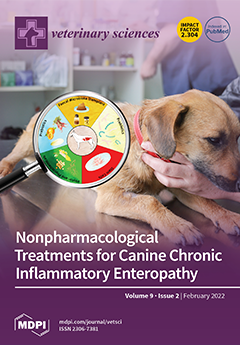The objective of this study was to investigate the effect of berberine (BBR) supplementation on productivity, antioxidant markers, and the fatty acid (FA) profile in the colostrum and milk of goats. Twenty-four primiparous Saanen goats were supplemented with 0, 1, 2, and 4 g/d (per goat) of BBR in control (CON), BBR1, BBR2, and BBR4 groups (
n = 6 per group), respectively, from 21 days before expected kidding to 21 days after parturition. Blood sampling was carried out at −21, −14, −7, 0, 7, 14, and 21 d relative to delivery. Colostrum was collected within the first and second milking (d 1 of lactation), and milk was harvested weekly after kidding. Both BBR2 and BBR4 increased dry matter intake (DMI) (
p ≤ 0.05) and energy balance (EB) as well as colostrum and milk production. Both BBR2 and BBR4 decreased (
p ≤ 0.05) plasma levels of cholesterol, haptoglobin, and ceruloplasmin, while elevating the plasma albumin and paraoxonase (
p ≤ 0.05), which may indicate that BBR mitigates inflammation during the transition period. BBR reduced (
p ≤ 0.05) malondialdehyde (MDA) and increased (
p ≤ 0.05) total antioxidant capacity (TAC), superoxide dismutase (SOD), glutathione peroxidase (GSH-Px), and catalase (CAT) in blood, colostrum, and milk. Concentrations of de novo fatty acid in colostrum and milk were increased (
p ≤ 0.05) with both BBR2 and BBR4. Free fatty acid (FFA) concentration in colostrum and milk fat were lower (
p ≤ 0.05) in BBR2 and BBR4 compared to CON. The concentration of saturated fatty acids (SFAs) in colostrum and milk fat increased (
p ≤ 0.05) with BBR2 and BBR4, while unsaturated fatty acids (USFAs) decreased (
p ≤ 0.05) in milk. In summary, supplementation with at least 2 g/d BBR may enhance the EB and antioxidant status of dairy goats.
Full article






